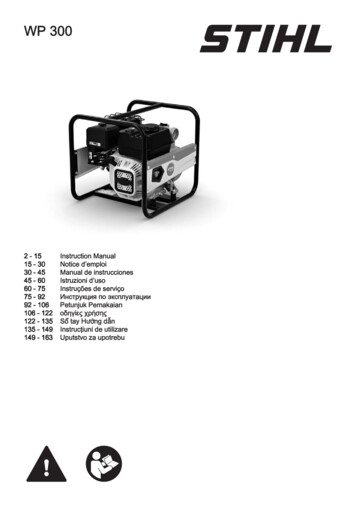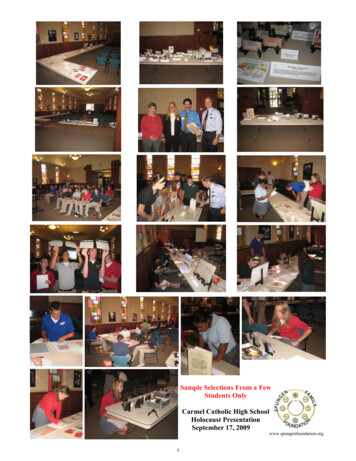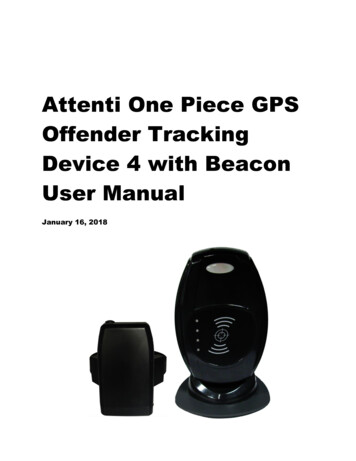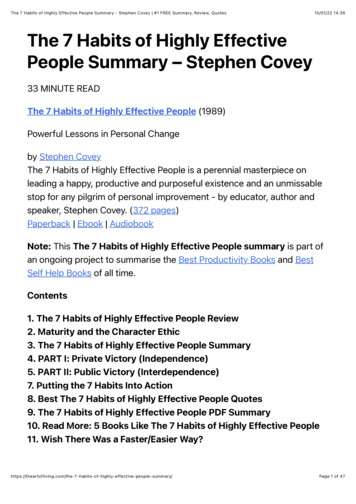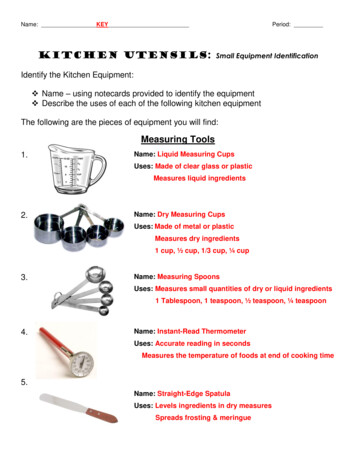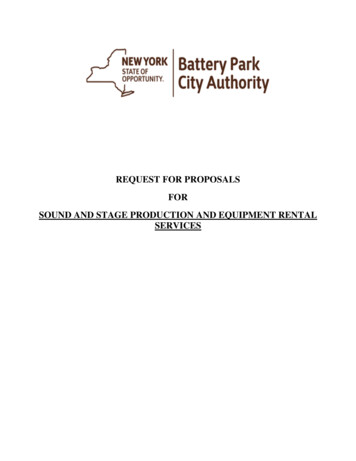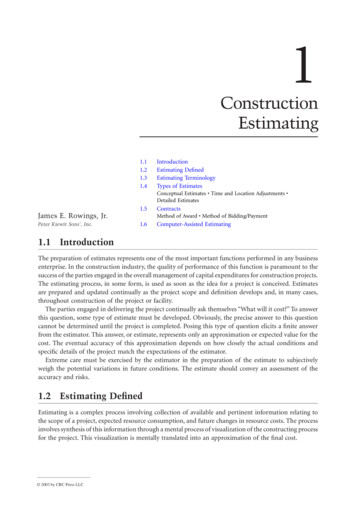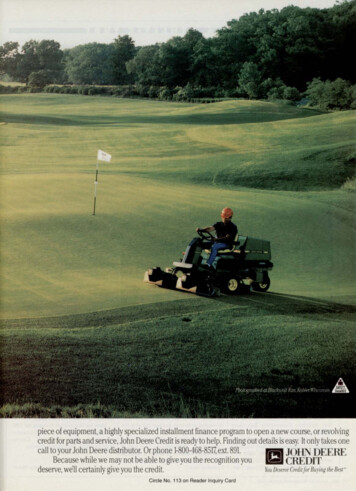
Transcription
piece of equipment, a highly specialized installment finance program to open a new course, or revolvingcredit for parts and service, John Deere Credit is ready to help. Finding out details is easy It only takes onecall to your John Deere distributor. Or phone 1-800-468-8517, ext. 891.B j a JOHN DEEREBecause while we may not be able to give you the recognition you gg CREDITdeserve, we'll certainly give you the credit.You Deserve Credit for Buying the BesfCircle No. 113 on Reader Inquiry Card
m avidi : ««Ji laiPast merges with modemday at Collier's ReserveFind the fairway: muchof the Collier'sReserve landscapeconsists of waterwaysand native vegetation.This Audubon SignatureCourse achieves a balancebetween a man's playgroundand an animal's refuge,thanks to good planning. Play a round at the Collier's Reserve golfcourse and you might feel like you're at playin both the past and the present.Man's handiwork is evident all around thecourse: concrete and asphalt, golf cars andgas pumps. But thanks to a successful program of habitat protection, most of thecourse remains as it was in centuries past:lush, wild, and untouched by man.In 1994, Collier's Reserve in Naples,Fla.—designed by Arthur Hills and managedby superintendent Tim Hiers—became thefirst Audubon Cooperative SanctuarySignature Golf Course in the U.S.The distinction signifies that a golf coursedesigner and superintendent have succeededin reaching five main objectives: water conservation; wildlife conservation; habitatenhancement; energy efficiency; waste man-Superintendent Tim Hiers: Predictsmore wildlife population Collier's.agement.It starts off the course—Energy andwater conservation begin in the clubhouse,maintenance shop and offices. Water inrestrooms is on automatic shut-off; hand dryers are used instead of paper towels; toiletshave one-and-a-half gallon capacity bowls;office windows are tinted for better insulation.Recycled plastic is used for parkingbumpers, benches and birdhouses, and double-vaulted tanks store gasoline and oil at themaintenance shop."Everything that could leak out here hascontainment," Hiers explains. "And even ifcontainment weren't mandatory, it would atleast be plain common sense. We want to seta standard here."ilaAs part of the habitat enhancement, morethan 500,000 native plants were placed byhand in areas that could have been plantedwith turf. "We don't use any (extraordinary)resources or labor to maintain them," Hierssays.Irrigation innovations—Each irrigationhead is placed according to the configurationof turf, down to the last leaf blade. The system distributes water exactly where it's needed, and all runoff water from turf areas flowsaway from native vegetation, as the bermudagrass needs a pH higher than that of thepines, and thus more frequent watering.A computerized weather station suggestsan irrigation schedule based on the dailyevapo-transpiration rate. "The weather station automatically adjusts output based oncurrent rainfall," says Hiers. "Proper programmanagement of the weather station eliminates overwatering."With the low pressure irrigation systemuses less water, and there is less water wastedby misting or drift. Energy use is greatlyreduced, and there are fewer pressure breaksin the system.Control products—W eed control, whichHiers says is minimal, is done by hand.Chemical control products are used to control turf disease—the bane of the southerngolf course. The bacterial product Bacillusthuringiensis is used for insect control.Nematodes are used to help control molecrickets.Bio-stimulants are used to improve thehealth of the soil, increase microbial activityand improve cation exchange capacity.Slow-release fertilizers reduce large flushes of growth, extend the feeding cycle andreduce the frequency and cost of fertilizerapplication.The wildlife at Collier's Reserve includeseagles, woodpeckers, ospreys, snakes, otters,owls, bobcats and crocodiles."I believe—and I think I can prove it—that there will be more wildlife activity created when this project is completed than beforethe first spade hit the ground, just because ofthe diversity out here," says Hiers.,"What's important is that, even if you don'tplay golf or care about golf, golf is good foryour community," says Hiers, "not onlybecause it provides oxygen and a habitat foranimals, but because it's a safe space."Hiers has been selected to receive the 1995President's Award for EnvironmentalLeadership from the Golf CourseSuperintendents Association of America.—Terry Mclver
PlanningaroundplayingMaintenance is up-to-date,and crews can do it all, astime is of the essence forRobert Mitchell andGreenbrier resort.by James E. Guyette At the Greenbrier resort hotel in WhiteSulphur Springs, W.Va., the guests pay plentyto play, and this presents a rigorous challengefor grounds superintendent Robert V. Mitchell."We don't want to inconvenience our guests,so we have to work around them," he says.The Greenbrier lies surrounded by 6,500acres of lush gardens, three golf courses and a212-unit residential housing development.Each year, the 60 groundskeepers and gardeners use two tons of grass seed, 200 tons offertilizer, 100,000 tulip bulbs (including forcedbulbs for indoor use), 70,000 summer annualflowers, 10,000 chrysanthemums (with anMitchell: Guests are here three or fourdays, and they want to play golf, notview construction.The Greenbrier's shrubs are grown along with a 5,000 square-foot Penncrossnursery and a two-acre bluegrass nursery featuring five varieties.added 2,600 shipped in from Kentucky for therecent Solheim Cup Golf Tournament), 7,000poinsettias, and 350 tons of sand to replenishgolf course bunkers.They came to play—Some 60,000 golfersannually hit the links, and when they step upto the tee they have no desire to view a workin-progress."Our guests by and large are here three orfour days, and when they want to play golf, theydon't want to be inconvenienced by bad conditions," says Mitchell. "They don't want to seethe same conditions that they see at theirhome country club."The maintained areas within the three golfcourses consist of 200 acres of bluegrass/ryegrass roughs, 65 acres of of bent/poa fairways,568,000 sq.ft. of bent/poa tees and puttinggreens.There are also two 11,750-sq.ft regulationcroquet courts with a special mix. And unlike agolf green, a championship croquet court(where the players wear white and keep silentduring shots) must be perfectly flat with nolumps or bumps.The resort's biggest months for guests areMay, June, September and October, whichmeans maintenance is tough. Each golf courseis renovated once a year. One at a time, theyare closed and renovated for a week in August"It's hard to grow grass in August,"Mitchell reports. "I'd like to do it in September,but that's impossible." No work in the spring,either. "I'd like to renovate in the spring, butwe can't because of the guest traffic."So August it is, although even that month isgaining popularity as a vacation stayover. "I don'tknow how long they'll give us a week percourse," Mitchell laments. "We try to do everything we can not to inconvenience our guests."Greens speeds are maintained at eight anda-half to nine on the stimpmeter—faster forspecial events.Greens on The Old White and Greenbrierare walk-mowed; a triplex is used on theLakeside greens. All three courses uselightweight mowers on the fairways.All-round turf care—Embark is used forseed suppression in early spring. Primo is usedthroughout the summer to help promote anincrease in bentgrass population on the fairways. TGR is applied to the croquet courts todeter Poa annua. Split applications of preemergence herbicides (pendimethalin onroughs and Dimension on fairways) are used.The black turfgrass ataenius and the Japanesebeetle grub are treated as needed via rotatinginsecticides. Fungicides are used on all greens,tees and fairways, and aerification of roughsand fairways begins in November.The Greenbrier is in the upper limits of thetransition zone because of its 1921-foot elevation, and it tilts toward the cool-season.Much of the resort's grounds are coveredwith a "condo mix" that tolerates sun andshade. "We change that mix from time to timeas better grasses become available," Mitchellexplains. The current lineup consists of red fescue with Baron, Midnight, and America, plusManhattan II ryegrass.Tree time—Much of The Greenbrier property is wooded. "We have a lot of trees to takecare of here." The consulting arborist is theDavey Tree Expert Co., and one full-time trimmer and a helper is on-staff.There are about 20 Dutch elms to becared for. "We climb them at least twice ayear," Mitchell reports. "We try to keep oursas disease-free as possible both mechanically(removing sick branches) and by injectionwith fungicides and spraying with dormantoil."—James E. Guyette, former editor o/"Lawn
THE BEAUTY OFUNSURPASSED GRUB CONTROLIS BEST SEENFROM YOUR GOLFER'SPOINT OF VIEW.To golfers, the only thing that matters is that your course looks and plays great.Which is why you should include MERIT Insecticide in your grub control program.MERIT controls grubs using an entirely new class of chemistrythat's even effective on insects resistant to other insecticides.In fact, MERIT has averaged 94% efficacy in the control of grubsin 88 trials across the country.One application in the spring to control billbugs and Hyperodes weevilsprovides enough residual to effectively control grubs throughout the summer.What's more, since MERIT works while usingremarkably low levels of active ingredient, it's less toxic to wildlife.To find out more, contact Miles Inc., Specialty Products,Box 4913, Kansas City, M O 64120. (800) 842-8020.And make MERIT part of your pest control program.Your golfers will like what they see.MILES95S19A0021 1995 Miles Inc Printed in U S A
BAYLETON FOR WETo stop enemy turf diseases from gaining a beachhead on your course, do what golf coursesuperintendents have been doing for 15 years. Apply BAYLETON Turf and Ornamental Fungicide.No other fungicide on the market has the proven history of preventing the toughest turf diseases.Whether the adversary is summer patch, dollar spot, anthracnose or any number of other majorturf diseases, BAYLETON consistently delivers unsurpassed control. And it's systemic for long residual.So after the initial application, BAYLETON has just begun to fight.It's a good tactic to apply BAYLETON over your entire course. By applying it on your fairways, 1995 Miles IncPrinted in U S A95S10A0023
you'll keep golfers from tracking disease up on to your greens and tees.And you'll get excellent control of powdery mildew and rust on ornamentals. What's more, BAYLETON comes in water soluble packets foreasy mixing and less applicator exposure.Jo find out more, contact Miles Inc., Specialty Products,Box 4913, Kansas City, M O 64120. (800) 842-8020.MILES A kThen, just apply BAYLETON, and the rout is on.ss ss
A superiorto any traditional fertFor greens, tees, low-cut fairways and other high-qualityturfgrass areas, SCOTTS TriaformtM technology offers you moreefficient nitrogen feeding compared to traditional urea formaldehyde (UF) or IBDU fertilizers.ÉL The Physical Advantage.A, The Agronomic Advantage.more consistent nitrogen release than you can get with physicallyWhat makes Triaform technology different is the pat-types and weather conditions, with more predictable controlledrelease, more total available nitrogen, and more consistent response.Triaform's homogeneous chemical composition provides ablended fertilizers. With Triaform, youll see immediate and residualented process that replaces highly water-insoluble nitrogenimprovement in the quality, color and density of the turf, with quickwith the shorter-chain, controlled-release methylenediureagreening and uniform color response for 8 to 12 weeks of feeding.(MDU) and dimethylenetriurea (DMTU).These compounds allow more efficient use of nitrogen andAnd Triaform granules disperse readily on contact withwater, without the material "gumminess" that causes particles toprovide faster particle breakdown on application to the turf.stick to spreaders, mowers, golf balls and golfers' shoes. SoNutrients release steadily and safely over a wide variety of soilplant-available nitrogen is not removed from the turf.IBDU is a registered trademark of Vigoro Industries. Inc.
alternativelizer you've ever used.A The Environmental Advantage.Because of its slow-release properties, Triaform technologyoffers significantly lower potential for leaching and volatilization.And the environmental benefits of Triaform technology extendto reduced emissions in the manufacturing process, which ispart of Scott's largest capital investment ever.Of course, with Triaform technology, you also get somethingno other brand of fertilizer can offer—a Scott Tech Rep, agronomically trained to help you develop a total turfgrass program withproper application and maintenance scheduling.For more information about the complete line of Triaformfertilizers, contact your Scott Tech Rep. Or call 1-800-543-0006.Triaform, Technology
Growing grass whenit doesn't want toThat's what's going on atSoldier Field and the Bears'practice fields over thecourse of 12 months.by Ken Mrock As groundskeeper for the Chicago Bears, Ihave to manage turf that takes the hardestbeating in sports turf. Over the past nineyears, I've seen the demands on our turfincrease dramatically. The players havebecome bigger and faster, and training isalmost year-round. This is tough because theMidwest has such a short growing season.If that weren't enough, consider aesthetics too. The Bears have about 10 televisionmedia outlets along with huge radio andprint coverage. The integrity of the playingsurface is always critical.This past season we had five mini-camps,several twice-a-day practices in addition toour normal four practices per week. On topof this, the Bears share their training fieldwith the Lake Forest College football teamfor five home games.With this schedule, the field doesn't haveas much time to grow grass. So what do wedo? Punt? Kneel down with the ball? No way.Assistant groundskeeper John Berta andI have put together an aggressive mix ofseeding and fertilization together with atight maintenance program to ensureBears' ballplayers have the best possibleplaying fields.It begins in March—Starting at the endof March, we pre-germinate seed—a mixture of Kentucky bluegrass, perennial ryegrass and Poa supina. As soon as the field isworkable, we aerify with a Ryan GA-30 orToro Greensaire. We bring up as many plugsper square foot as possible. This speeds germination and establishes the plant a littlelower in the turf surface, somewhat protecting the plant from the cleats of the players.We allow the plugs to completely dry.Then we broadcast the pre-germinated seedmix over the entire practice field and addanother 7-8 lbs./l,000 sq. ft. of dry seedbroadcast mainly between the numbers.This area is the most worn due to the shortpassing game of our "West Coast Offense"where three or four receivers line upbetween the hash marks and numbers, cutting and spinning their wayup the field. With the receivers, of 1course, come the defensive backsand linebackers. This puts six toeight players in a small area.Since we have no internaldrainage and the practice field wasconstructed with Turface calcinedclay, we have continued to applyTurface and our topdressing soil tothe practice field with a TurfcoMetermatic top dresser. We applythis mix across the entire field then lightlydrag all the material in with a draft mat.Then we fertilize with a starter fertilizer,usually Vicksburg Chemical's K-Power 1334-12. It offers potassium nitrate for theestablished turf, quick release nitrogen thatworks well in cool soil, and phosphorous forseed germination and root establishment.Then we apply pythium control and coverthe entirefieldwith a frost blanket.Spring mini-camp—Mini-camp hits inlate April—three days of twice-a-day practices with about 80 players. I call this ouropening day. Daily maintenance on the fieldis quite aggressive. Divots must be replacedafter every practice. The ones that can't be"found" are replaced with a mixture of seed,topsoil and Turface.In early May, we fertilize with K-Power12-0-42 along with spot treatments forbroadleaf weeds. A Kiffco B-140 water reelirrigates the field before dawn so that theplants are dry by evening. Under normalconditions, we irrigate about twice weekly,putting down A-\ inch of water per application. By mid-June, we're putting down ahalf-rate of K-Power 12-0-42. This strengthens thefieldfor the last two mini-camps.Around mid-July, we take a break inpractice scheduling and the team moves tothe University of Wisconsin at Platteville forfour weeks. Although it's a tough time forseed development, it's our only window. Weaerify the turf in two directions, overseed,topdress and make another application of12-0-42. Fungicides and insecticides can beused, but sparingly. We also do another spotspraying for broadleaf control, usuallydicamba for knotweed and clover control.Going g e t s tough—August is thetoughest stretch of our turf managementprogram. Our team is in training camp,two-a-day practices with 80 players. Wemow daily after every practice, sometimestwice a day, to allow a light rolling. Wemaintain the turf at about VA inches with aJacobsen Tri-King 84 inch reel-type. This isa lightweight mower and allows us to pattern the turf five yards in one direction andthe next five in the opposite direction. Theballplayers like close-cut turf.With cooler weather in September, weshift our fertility program to 18-3-18 withboth quick and slow-release nitrogen. Whenthe nights begin to drop to 35 F., we pullout the frost blankets to raise the soil temperatures. This really kicks in the fertilizer.We also use our rain/snow tarps as needed, covering 140 x 65 yards in seven sectionsthat zipper together to form one solid tarp.Other than during a Bears practice or a college game, no rain or snow is allowed toaccumulate on the practice field.As the season progresses, we pump 4million BTUs of heat via kerosene-firedheaters under the tarps to keep the fieldfrom freezing. The only time the field isuncovered is for practice during Novemberand December and hopefully January—playoff time. The increased levels of potassiumallow us to literally beat up this field, but itkeeps getting up. In mid-November, weapply a full rate of 12-0-42 to take usthrough until the spring.—The author is grounds superintendent forthe Chicago Bears professional football team.
call to your John Deere distributor. Or phone 1-800-468-8517, ext. 891. . maintenance shop and offices. Water in restrooms is on automatic shut-off; hand dry-ers are used instead of paper towels; toilets have one-and-a-half gallon capacity bowls; office windows are tinted for better insula-tion. Recycled plastic is used for parking


